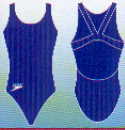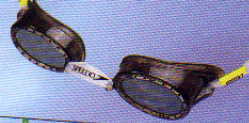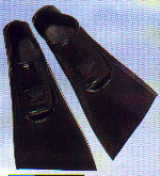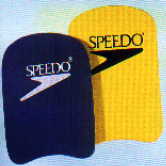|
Swimming Suits:
 I really don't think I need to explain these much. There many major manufacturers, but Speedo and TYR are probably the most popular. Suits come in all different styles and can be very expensive. However, it is recommended that you have at least 2 practice suits and 1 competition. This will help increase their life. Also, see my swim suit care page.
I really don't think I need to explain these much. There many major manufacturers, but Speedo and TYR are probably the most popular. Suits come in all different styles and can be very expensive. However, it is recommended that you have at least 2 practice suits and 1 competition. This will help increase their life. Also, see my swim suit care page.
|
Cost: | Men $20-$40; Women $40-$60 (on average; but it really depends on the brand and quality) |
|
Life: | 1-2 years, depending on how often suit is used |
|
Suppliers: | Sporting goods stores, through your swim team, swim meets, mail order catalogs, general stores (like Target, Walmart), etc.
|
Goggles:
 Goggles are basically 2 plastic lenses connected with an adjustable nose-piece and are held onto the head with rubber or silicon straps. There are tons of different models - hologram goggles, low-profile goggles, mirrored goggles (My favorites, really useful during backstroke in outdoor pools), and racing goggles which do not have gaskets (they aren't really the most comfortable things).
Goggles are basically 2 plastic lenses connected with an adjustable nose-piece and are held onto the head with rubber or silicon straps. There are tons of different models - hologram goggles, low-profile goggles, mirrored goggles (My favorites, really useful during backstroke in outdoor pools), and racing goggles which do not have gaskets (they aren't really the most comfortable things).
|
Cost: | $5 cheap - $20 racing or mirrored |
|
Life: | 2+ years, since you can buy replacement parts. Usually it isn't really worth it though, unless you have really good goggles. |
|
Suppliers: | Sporting goods stores, swim meets, mail order catalogs
|
Swim Caps:
Swim caps can be either latex, silicon, or lycra (it's kind of like the material most swim suits are made out of) and are worn on the head over the hair to reduce drag. Obviously, all have advantages and disadvantages:
Silicon caps will usually last the longest, but don't stay on your head as well. Because they last so long they are also more prone to accumulate mildew and other nasty stuff if you're not careful.
Latex caps most likely will not last more than a couple of months (the material is comparable to a thick balloon, and they break very easily, but in my opinion they work the best as they provide the tightest fit on your head), but they're also extremely cheap. If you choose to use this kind, I would advise keeping a couple extras in your swim bag. This is also the material most teams' caps are made out of.
Lycra caps stretch out until they can practically fit over your whole head after awhile. However, because they are made from fabric and don't fit as tight, they're probably the most comfortable and won't pull on your hair as much as a latex cap can.
You just kind of have to try all three and judge for yourself.
|
Cost: | About $12 silicon, $3 latex, or $9 lycra |
|
Life: | Varies - for the most part, anywhere from 1 month - 1 year |
|
Suppliers: | Sporting goods stores, swim meets, through your swim team, mail order catalogs
|
Training paddles:
   Basically a thin slab of plastic. There are several styles of these, the most common 2 are rectangular shaped things and the Catalyst paddles which are larger and almost mitten-shaped (pictured far left). These are the ones that I use, and I like them a lot. Paddles are attached to the hands, most commonly with rubber tubing. They are used mainly for improving freestyle arm stroke technique. Note on these: learn to use them right, they can really damage your shoulders.
Basically a thin slab of plastic. There are several styles of these, the most common 2 are rectangular shaped things and the Catalyst paddles which are larger and almost mitten-shaped (pictured far left). These are the ones that I use, and I like them a lot. Paddles are attached to the hands, most commonly with rubber tubing. They are used mainly for improving freestyle arm stroke technique. Note on these: learn to use them right, they can really damage your shoulders.
|
Cost: | $8.50 - $20 Catalyst |
|
Life: | Should last a long time, you can replace the tubing |
|
Suppliers: | Through your swim team, swim meets, mail order catalogs
|
Swim Fins:
 Usually made out of rubber or another flexable and durable material, fins are worn on the feet and are used mainly during kicking exercises and drills. They should fit fairly tight, and can be a little hard to get used to. (If your fins are a little to big or uncomfortable, wear a pair of socks when you use fins. This sounds dumb, but it works well.) They're made long, so most coaches will have you cut them down to about 5". Note: Be careful if you are swimming extremely hard, (especially on butterfly), with fins. It can cramp up your calf muscle. This hurts extremely bad, and it takes forever to work out the cramp.
Usually made out of rubber or another flexable and durable material, fins are worn on the feet and are used mainly during kicking exercises and drills. They should fit fairly tight, and can be a little hard to get used to. (If your fins are a little to big or uncomfortable, wear a pair of socks when you use fins. This sounds dumb, but it works well.) They're made long, so most coaches will have you cut them down to about 5". Note: Be careful if you are swimming extremely hard, (especially on butterfly), with fins. It can cramp up your calf muscle. This hurts extremely bad, and it takes forever to work out the cramp.
|
Cost: | Around $20 |
|
Life: | A few years |
|
Suppliers: | Should be easy to find - sporting goods stores, through your swim team, swim meets, mail order catalogs, general stores (Target, Walmart), etc. |
Pull Buoys:
   Made from foam, or other lightweight, buoyant materials, pull buoys are shaped kind of like binoculars and are placed between the thighs so swimmers can work on arm strengthening or stroke-improving sets. When using buoys, your arms are almost forced to make slow, long strokes or else your swimming turns extremely fast and sloppy. They are often used at the same time as hand paddles to work on freestyle technique.
Made from foam, or other lightweight, buoyant materials, pull buoys are shaped kind of like binoculars and are placed between the thighs so swimmers can work on arm strengthening or stroke-improving sets. When using buoys, your arms are almost forced to make slow, long strokes or else your swimming turns extremely fast and sloppy. They are often used at the same time as hand paddles to work on freestyle technique.
|
Cost: | Anywhere from $6 - $16 |
|
Life: | Maybe 5 years or so |
|
Suppliers: | Through your swim team, swim meets, mail order catalogs
|
Kickboards:
  Most kickboards are made of cellular plastic or foam and are usually supplied by the coach or organization. Swimmer holds onto the sides of the kickboard, allowing only the use of the feet and legs to move through the water. Some of the most fun drills involve kickboards. Usually about 11" wide by 20" long. They break fairly easily.
Most kickboards are made of cellular plastic or foam and are usually supplied by the coach or organization. Swimmer holds onto the sides of the kickboard, allowing only the use of the feet and legs to move through the water. Some of the most fun drills involve kickboards. Usually about 11" wide by 20" long. They break fairly easily.
|
Cost: | You normally don't have to buy these. They're about $12 though. |
|
Life: | A long time. Most break easy though. |
|
Suppliers: | Sporting goods stores, mail order catalogs
|
|